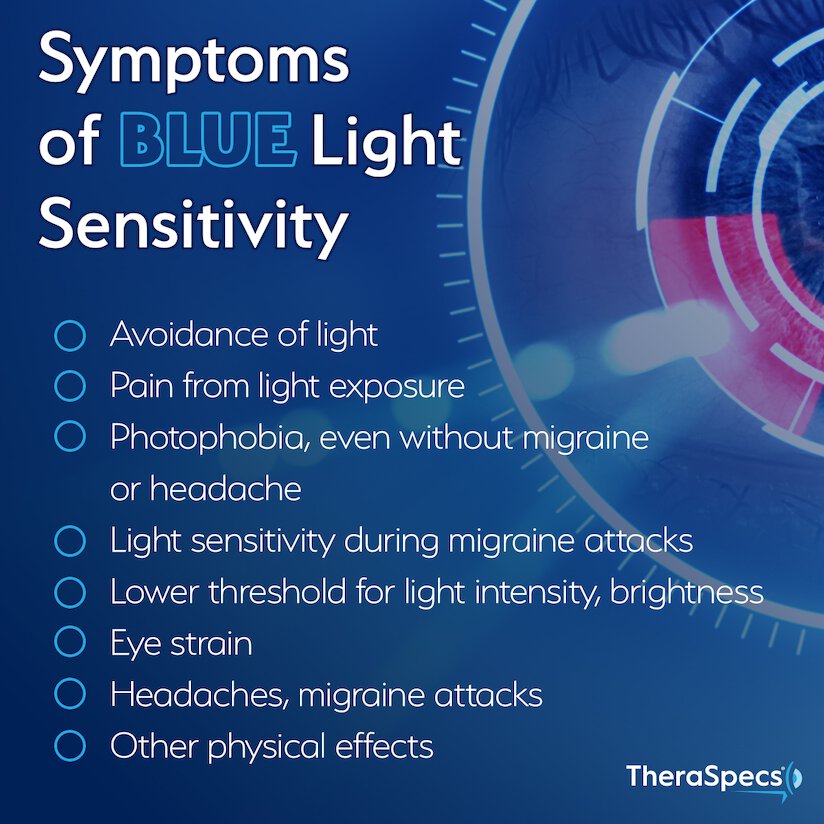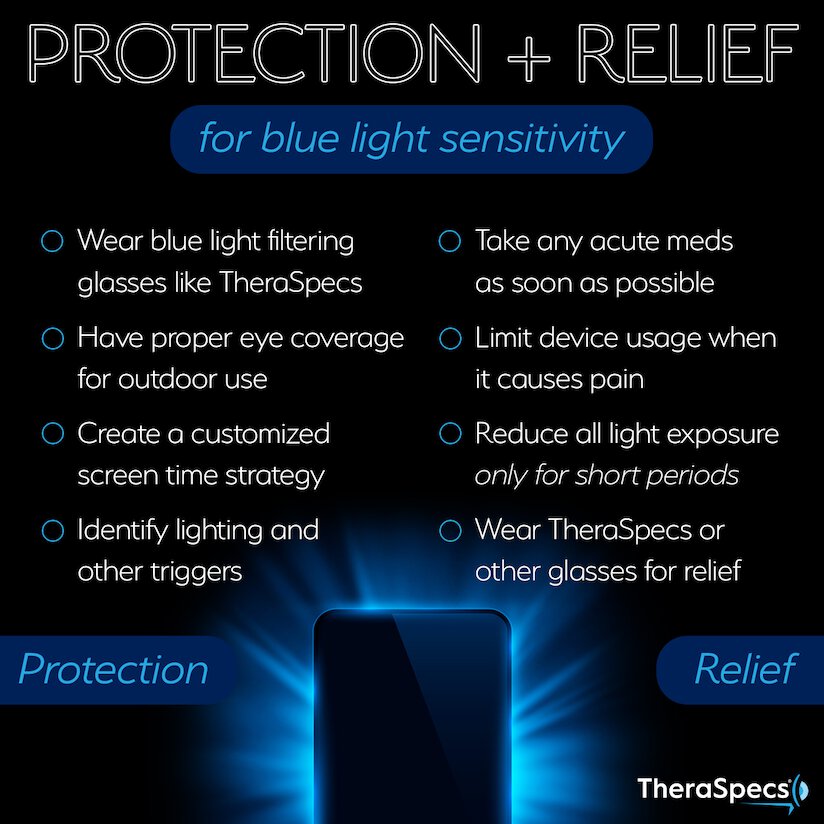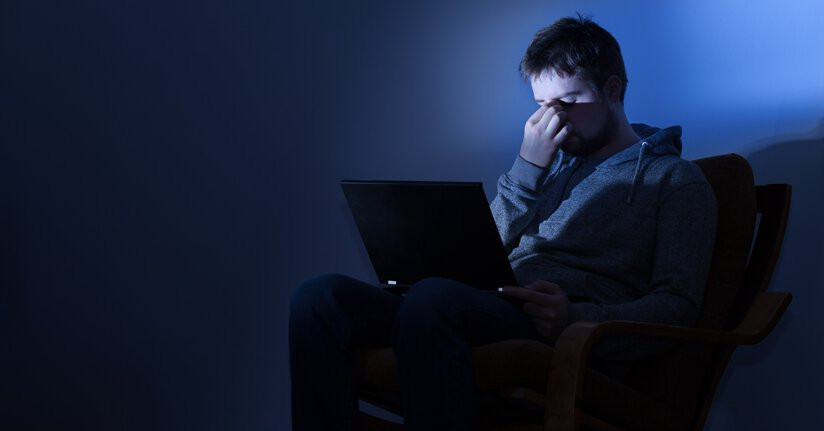Blue Light Sensitivity: Causes, Symptoms and Protection Strategies
We all experience some level of sensitivity to blue light, based on the physiological makeup of our eyes and how they receive and interpret light. However, this is a natural process that usually does not manifest into anything unhealthy or burdensome. But for some, certain exposure to blue light can lead to the onset of symptoms like headaches or eyestrain, especially in those with underlying sensory sensitivities.
Causes and Symptoms of Blue Light Sensitivity

iPRGCs and 480nm Blue Light
As we mentioned, we are all blue-light sensitive to some extent. This is the result of specific cells in our eyes called intrinsically-photosensitive retinal ganglion cells (iPRGCs for short) that are activated by blue light with a peak wavelength of ~480nm. Again, for most of us, this is a naturally-occurring process that never results in harmful side effects, but people with photophobia—especially from migraine—have negative reactions to this blue light. This includes symptoms like:
- Aversion to or avoidance of light
- Pain from light exposure
- Photophobia, even without migraine or headache
- Interictal light sensitivity in migraine, which occurs between attacks
- Lower threshold for light intensity, brightness
- Headaches, migraine attacks
- Eye strain
- Other physical effects pertaining to a light-sensitive disorder, such as dizziness/vertigo or eye dryness
While we don’t have a precise understanding of exactly why this occurs, there is significant evidence that iPRGCs are at the center of it. In fact, blind individuals with migraine can and do experience blue light sensitivity as a result of these retinal cells because they are not part of the visual pathway—but they do connect to pain centers in the brain.1 Rods and cones (which are part of vision formation) along with other neurological deficits may also combine to produce photophobic responses to blue light at 480nm.
If you have another light-sensitive diagnosis, such as dry eye, traumatic brain injury or blepharospasm, you can also exhibit hypersensitivity to this wavelength of blue light. And even if you have no known cause for your photophobia, light in the blue spectrum can still trigger your symptoms.2
Other Explanations and Experiences
The source of blue light may also matter in the sensitivities that follow. For example, conventional fluorescent lighting produces a non-visible flickering that is absorbed by the brain and has been shown to trigger headaches and eye strain, even in those without a preexisting condition.3 This invisible flicker is at its most potent in the blue light spectrum.
Not surprisingly, everything gets “turned up” when the brightness of the light is also heightened. There are more blue wavelengths in natural sunlight (perhaps as much as 250 times more!), which can combine with the intensity to set our symptoms in motion. After all, it’s why most of us are likely to reach for dark sunglasses before going outside. And if you have existing blue light photophobia, you face an elevated risk; just a few minutes of exposure to bright outdoor light can trigger an attack.
Other wavelengths within the blue spectrum may also have negative consequences, but researchers have not been able to agree on the validity of that conclusion. Regardless, it seems like there is some potential harm that comes from shorter wavelengths of blue light between 400-470nm, which might cause damage to the eye and ultimately contribute to visual deficits later in life. But again, it appears that it would require constant subjection over a long period of time at relatively high brightness levels, higher than what comes from your screens for example. In addition, this is less about being sensitive to blue light—in fact you may feel completely fine in the moment—and more about the long-term effects of repeated exposure.
Temporary sensitivity to blue light can occur when faced with these shorter wavelengths as well. Tablets with LED displays, which have high blue light emission between 440-470nm, can induce visual symptoms like tired or irritated eyes.4 The more we use our devices, the more likely we are to feel the effects of digital eye strain too, which can include a variety of symptoms like:
- Eye pain, irritation
- Visual fatigue
- Headaches
- Migraine attacks
- Dry eyes
- Blurry vision
- Increased light sensitivity
Again, it remains unclear just how much of a role our inherent sensitivity to blue light plays in their onset, but they have impacted most of us at one time or another. Although many other factors may help bring about these symptoms, general evidence suggests that non-blue wavelengths simply do not add to the discomfort or pain that many feel when exposed to blue light—even when accounting for brightness levels and other lighting conditions.5
Strategies for Blue Light Protection and Relief

It is vital to first see a doctor or specialist if you are experiencing photophobia of any kind. You want to get to the root cause of your sensitivity to blue light, especially because there may be treatments for the condition that can also significantly relieve your light sensitivity too.
Additional strategies can be broken down into prevention of the onset of symptoms and relief once they have already taken hold. For prevention, you can try:
Wearing 480nm-filtering photophobia glasses like TheraSpecs (FL-Pro and FL-Blend for indoor use; dark, polarized FL-Sun for outdoors) that are designed to eliminate the most harmful wavelengths of blue light—and thus prevent episodes of light sensitivity
Using blue light glasses with other filtering properties based on where you may be most sensitive. TheraSpecs also offers Contrast HEV to cut out artificial blue light near 450nm and help promote sharper vision (read our roundup of the best blue light glasses for light sensitivity here)
Having proper eye coverage when you’re outdoors, e.g. dark and polarized sunglasses, and utilize shade as much as possible
Developing a customized screen time strategy, which may include limiting usage before bed, utilizing devices in well-lit environments, and/or taking advantage of accessibility features such as color shift to prevent discomfort
Identifying lighting and other symptom triggers, such as big box stores with bright fluorescents, and taking additional safeguards to reduce their impact
If you have already started to develop symptoms associated with your blue light sensitivity, there are some steps you can take to counteract their negative influence. This can include:
Taking any acute medications associated with your condition as soon as possible, since they can often blunt the worst of the discomfort when taken early
Halting or significantly limiting your device usage when it causes pain or other negative effects in order to avoid worsening photophobia
Reduce your exposure to all light *in the short term*, which may mean utilizing a dark room or covering/closing your eyes for a few minutes (or even hours) in order to allow the brain to recover
Increasing your light exposure as long as you can tolerate it; it may seem like an unusual strategy, but you do not want to avoid all light for significant periods of time as it can worsen photophobia (including to blue light) in the long run
Wearing TheraSpecs blue light blocking glasses for relief; not only can they prevent episodes of light sensitivity, but in many cases, they can provide a respite for active symptoms
Related Reading: Blue Light Glasses
Do Blue Light Glasses Help with Headaches, Migraines and Other Symptoms?
Do Blue Light Glasses Help with Fluorescent Lights?
FL-41 Glasses vs Other Blue Light Glasses: Which is More Protective?
Do Sunglasses Help with Outdoor Blue Light Protection? A Comparison of Top Brands
References:
1Noseda R, Kainz V, Jakubowski M, et al. A neural mechanism for exacerbation of headache by light. Nat Neurosci. 2010;13(2):239-245. doi:10.1038/nn.2475
2Panorgias A, Lee D, Silva KE, Borsook D, Moulton EA. Blue light activates pulvinar nuclei in longstanding idiopathic photophobia: A case report. NeuroImage: Clinical. 2019;24:102096. doi:10.1016/j.nicl.2019.102096.
3Wilkins AJ, Wilkinson P. A tint to reduce eye-strain from fluorescent lighting? Preliminary observations. Ophthalmic Physiol Opt. 1991;11(2):172-175. doi:10.1111/j.1475-1313.1991.tb00217.x
4Kim DJ, Lim CY, Gu N, Park CY. Visual Fatigue Induced by Viewing a Tablet Computer with a High-resolution Display. Korean J Ophthalmol. 2017;31(5):388-393. doi:10.3341/kjo.2016.0095
5Marek V, Reboussin E, Dégardin-Chicaud J, et al. Implication of Melanopsin and Trigeminal Neural Pathways in Blue Light Photosensitivity in vivo. Frontiers in Neuroscience. 2019;13. doi:10.3389/fnins.2019.00497.
Last updated 25th Mar 2024
TheraSpecs Glasses for Light Management
Try our light-filtering glasses and stay protected against harsh light from screens, fluorescents, LEDs, unwanted blue light, bright sunlight, flashing lights, and more.





